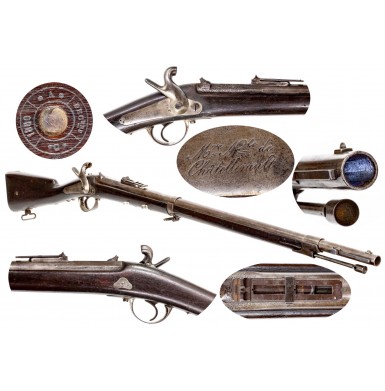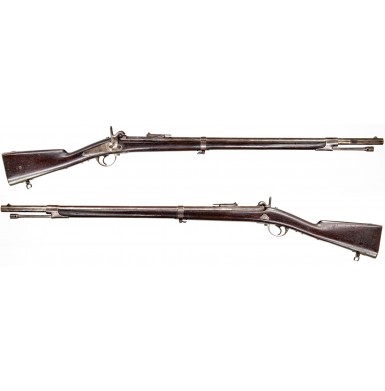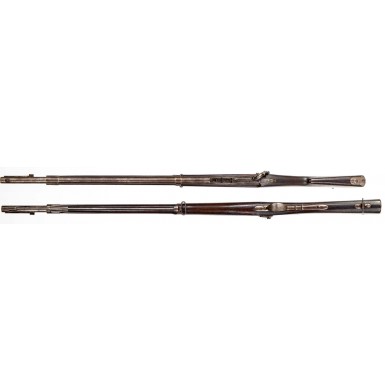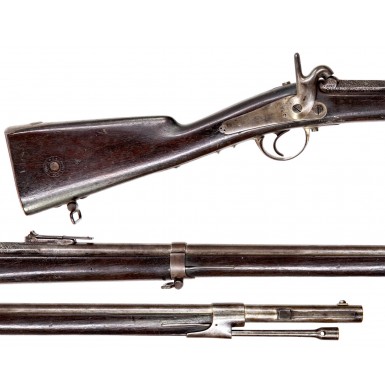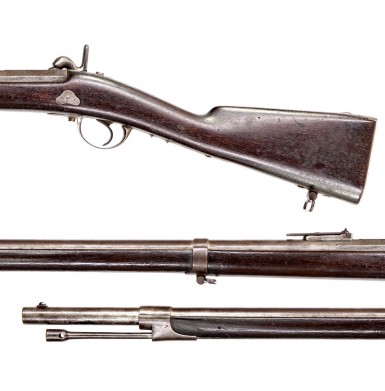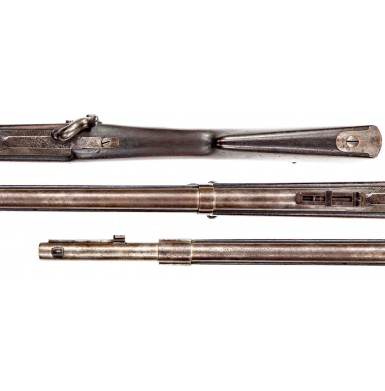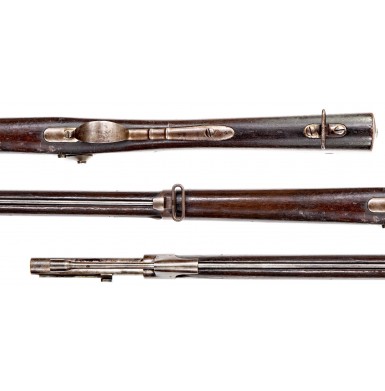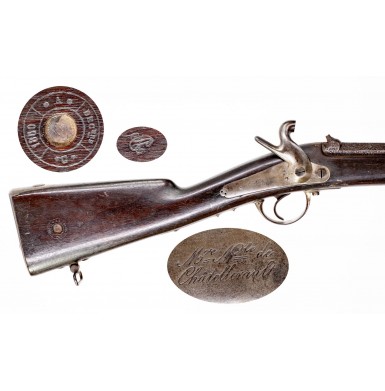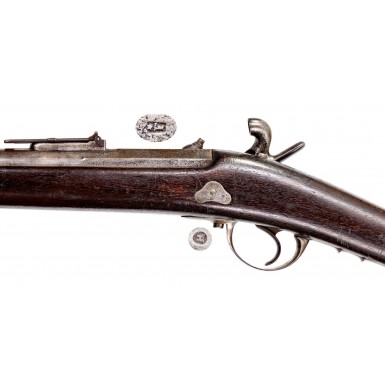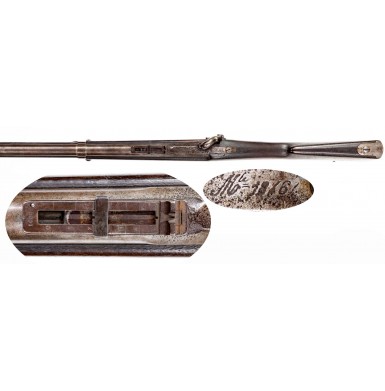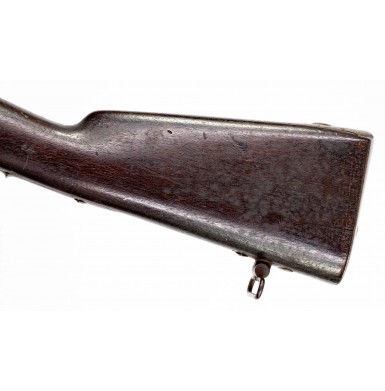French "Carbine a Tige" Model 1846 Rifle
- Product Code: FLA-3717-SOLD
- Availability: Out Of Stock
-
$1.00
In 1837, the French military adopted the percussion ignition system for their small arms. The first newly produced percussion arm to be manufactured by the French was the Model 1837 Delvigne-Pontcharra “Sharp Shooter’s Carbine”. The rifle-length percussion ignition muzzleloader had a 34.25” (870mm) barrel with an 18mm bore rifled with six rounded grooves. The gun introduced a rudimentary back action lock to French long arms and Delvigne’s chambered breech system. This system provided a sub-caliber chamber for the powder, with a lip upon which the bullet sat. By striking the bullet a hard blow with the heavy, cupped-head ramrod it was slightly compressed, which expanded the base of the bullet, so it would engage the rifling in the bore. The M1837 Rifle used a propriety bullet with a special sabot designed by Colonel Pontcharra, thus the dual designation of the design as Delvigne-Pontcharra. With this system the first sub-caliber, “expanding base” ammunition was utilized in a percussion military arm, providing the genesis for the design of Claude Minié, which would result in the development of the most successful and famous of this pattern of ammunition, the Minié Ball.
In 1840, the French began the process of updating their stocks of older flintlock weapons to percussion. At the same time, they adopted a new pattern of light infantry rifle, the Model 1840, known as the Carbine de Munition. This rifle retained the Delvigne chambered breech but reduced the groove-to-groove caliber to 17.5mm (about .69 caliber), although most references measure the groove diameter at nominally .71 caliber. It adopted a slightly shorter, 32.625” barrel and introduced more conventional, four-groove rifling for the bore with a rather slow twist of about 1:65, essentially ½ turn in the length of the barrel. The back action lock was also refined. Finally, a long-range rear sight, consisting of a fixed notch and folding leaf with apertures for 300, 400, 500 and 550 meters was added. The sight was not marked with graduations. The new rifle, also known as the Carbine du Thierry, was iron mounted with a pair of spring-retained barrel bands, the upper slightly larger than the lower. The triggerguard tang retained the finger grooves that had been common on French muskets since the beginning of the 19th century, and a pair of sling swivels were provided on the lower barrel band and in the toe of the stock. A saber bayonet lug without a guide key was located on the right side of the barrel near the muzzle. As with the Model 1837, a heavy cupped-head ramrod with a torque hole was provided to upset the ammunition in the Delvigne breech. The long chambered breech is clearly identifiable by the seam between the breech and barrel, which is visible just forward of the rear sight base. While the Model 1840 was the first widely issued rifled arm to see service with the French military, it was rather quickly superseded by the Model 1842 Rifle, which retained the Delvigne breech, but which had the breech and bolster forged as part of the barrel, rather than threading the breech assembly into the barrel. In 1846, the French abandoned Delvigne’s chambered breech design in favor of the Thouvenin “pillar breech” system. These arms were known as the Carbine à Tige and relied upon a pillar in the breech to assist with the mechanical engagement of the bullet with the rifling. The heavy cupped ramrod was used to force the bullet against a post or pillar-like projection at the rear of the chamber. The powder for the charge surrounded the pillar and the impact of the ramrod on the nose of the bullet was intended to force the base of the bullet to expand against the pillar and engage the rifling. The system was probably quite functional on paper and probably equally so in testing. In the field, however, it was a disaster. The bullet often landed on the pillar slightly off-center or tilted, and the resulting impact simply deformed it and often forced the base to engage some rifling, but not necessarily all of it. The deformed bullet then left the muzzle with erratic accuracy at best. Additionally, the powder fouling around the pillar had to be meticulously cleaned or eventually the carbon buildup and residue would result in the new powder charges covering the pillar preventing the bullet from seating correctly and impacting the pillar with any real force when rammed. Again, this created very erratic accuracy. The pillar itself could even be eroded by the constant heat and corrosive components of the percussion caps, resulting in it weakening and possibly breaking. Of all the French rifle systems of the mid-19th century it was the least reliable as it relied solely on the soldier’s ability to maintain the weapon to perfection and load it perfectly to work as designed.
After a decade of dealing with the Thouvenin rifle’s numerous short comings, the French finally adopted Claude Minié’s expanding base ammunition design, and adopted the Model 1857 rifle, officially making all of the earlier designs obsolete. Even this new rifle was replaced very quickly the Model 1859 rifle, as the French tried desperately to compete in an arms race that pitted their muzzleloaders against the bolt action Prussian Model 1841 Needle Rifle. The M1857 and M1859 Rifles were known as Chasseur de Vincennes rifles, although the name appears to have been applied interchangeably to some of the earlier pillar breech rifles as well. This is likely because many of the M1846 Carbine à Tige Rifles had their pillars removed after the adoption of the M1857 and subsequently saw service with traditional Minié ammunition. The M1859 was the last of the percussion ignition, muzzleloading rifles to see French service, as their next official rifle would be the Model 1866 Chassepot; a single shot, bolt action breechloading rifle that used a combustible cartridge.
With the coming of the American Civil War, many of the obsolete pattern rifles were sold to US buyers. Herman Boker purchased 8,689 Delvigne Rifles that were likely a combination of by M1840 and M1842 rifles. This represents about 24% of the total of some 36,000 French and Belgian pattern rifles purchased by US buyers. The balance were a combination of Thouvenin pattern pillar-breech rifles and the newer M1857 and M1859 Minié Rifles. C.K. Garrison delivered some 20,938 “Chasseur de Vincennes” Rifles to the Ordnance Department, but these were almost certainly a combination of all the later, post-Delvigne pattern arms. More than likely some were of Belgian origin as well. These rifles were typically categorized by the Ordnance Department as “Rifles, Belgian or Vincennes, Saber or Sword Bayonet - .71 caliber.” Interestingly, by the Franco-Prussian War in 1869, the French were using one of the most advanced beech loading, bolt action rifles in the world; the Model 1866 Chassepot which had replaced the M1859 rifle. However, due to the limited availability of the new rifles, thousands of obsolete muzzleloading percussion rifles were pressed into service. Many were also altered to cartridge via the Tabatière system, which was the French equivalent of the British Snider and US Trapdoor alterations. Although the Chassepot was superior to the Prussian needle rifles, the percussion and cartridge altered rifles were woefully inadequate in combat against the more modern Prussian arms and proved no match for them.
Offered here is a NEAR VERY GOOD, solid and complete example of a French Model 1846 Thouvenin Percussion Rifle, or Carbine à Tige. The back action lock is clearly marked in two script lines: Mre Nle de / Châtellerault, indicating the rifle was produced the National Manufactory (armory) at Châtellerault. The designation of the armory as national, rather than “imperial” or “royal” indicates that the rifle was produced during the brief period of the 2nd French Republic, under the rule of an elected Napoleon III from 1848-1852. In 1852, the marking would change again to “imperial” as France entered its 2nd Empire period, again under Napoleon III, which lasted until 1870. The tang of the rifle’s barrel is clearly marked Mle 1846. The stock has a clear storekeepers roundel stamped around the remnants of the government ownership boxwood plug. The storekeeper’s mark is dated 1860, which was probably the year the gun was modified by the removal of the Tige from the breech, as there is no pillar present in the gun. Normally the year of production would be present on the right angled flat of the breech, forward of the bolster, but this is obscured by pitting in this region. As would be expected a plethora of small French inspector and controller marks around found throughout the gun.
The rifle has a 34 1/8” long barrel rifled with four grooves and measures right at .71” which is the nominal French standard of the era, .708” caliber. The rifle is 49 3/8” in overall length. The rifle appears to remain in its 100% complete, correct and original configuration in all respects. The gun has a thinly oxidized brown patina with scattered surface roughness and scattered light pitting over most of the metal, as well as some areas of more moderate pitting. The breech area in particular shows moderate or even heavy pitting as far forward as the rear of the base of the base of the rear sight, with the metal forward of the rear sight much smoother. The breech has a grayer patina with a salt and pepper appearance from the dark discoloration in the pitted areas. The action of the rifle remains fully functional with the lock operating crisply and correctly in both the half and full cock positions. The percussion cone (nipple) is heavily battered, somewhat damaged and worn, but this is not visible when the hammer is in the lowered position. The bore of the rifle retains strongly visible rifling, but is heavily oxidized and moderately pitted, rating only about GOOD over all. It is likely that a good scrubbing would improve the bore at least slightly, but this rifle will not likely ever be a shooter. The original and correct 1,000-yard adjustable leaf rear sight is in place on the breech, as is the accompanying front sight blade on a block base. The original saber bayonet lug and long guide key are in place on the barrel and both original sling swivels are in place on the rifle as well; one in the toe of the stock and one on the lower barrel band. The original ramrod is in place in the channel under the barrel. The rod is full-length and retains fine threads at the end. It appears short when fully inserted in the ramrod channel but is correctly 32 ½” long, correct to ram the bullet against the Tige pillar that is no longer present. The stock of the rifle remains in VERY GOOD condition. The stock does not appear to have been sanded as the storekeeper’s cartouche is still fairly crisp. As noted, the boxwood plug is partially missing from the stock, but at least one layer of contrasting wood remains in the hole. The stock does not appear to have been cleaned in a very long time and shows some scattered dirt and grime as well as what looks like some light mildew staining on the obverse butt and some scattered flecks and small splotches of white paint; not an uncommon thing to find on an old musket stock. The stock is full-length and free of any breaks or repairs. There is a grain crack in the butt the extends from the butt plate about 2 ½” toward the wrist. The crack is visible on both sides but remains very tight and appears very stable. As expected, the stock shows numerous scattered bumps, dings, scuffs, mars and surface scrapes that are typical of a 150+ year old military rifle that may spent most of the last century in an attic or similar location.
Overall this is nice, solid, and unmolested, complete and correct example of a scarce French Model 1846 Carbine à TigeRifle. These rifles were only produced for about a decade, which is not a significant period of time during that era. Many that remained in France were later altered to cartridge for use during the Franco-Prussian War, leaving percussion examples somewhat scarce. While it is impossible to know if this rifle came to America during the American Civil War or remained in France to Franco-Prussian War service, the lack of cartridge alteration and that fact that it has survived both suggest that this may well be one of the many French rifles that saw use during the early part of the American Civil War. As such, it would be an appropriate addition to any collection of Civil War era import arms.
SOLD

